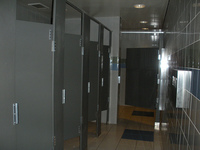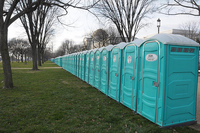When you gotta go, where do you go?
We’ve all been there. You’re out and about, and then suddenly, you need a restroom. When I leave home to go on a walk or run an errand, I keep a mental map of the closest available restrooms. I usually rely on restrooms in commercial businesses, largely because it is difficult to find public restrooms in the District.
Access to public restrooms is more than a matter of convenience. It is also an issue of public health and key to creating a comfortable, walkable, livable city.
The availability of public restrooms enables people to leave their cars at home and commute on foot and on mass transit. Public restrooms significantly cut down on the public urination and defecation and make our downtown streets much more inviting.
The American Restroom Association suggests that every incorporated municipal district, city, or town should provide access to restrooms for the public at all times of the day and at any time of the year. Jurisdictions that are unable to provide dedicated public facilities should allow the public access to public toilet facilities in government buildings that are continually operational, such as police, fire stations, and hospitals.
Not all public restrooms are alike. The choice of facility depends on existing infrastructure, available management options, maintenance budgets, and overall population size. Here are examples of the most common facility types:
- Automatic Public Toilets (APT): These are self-cleaning units. The cleaning process takes about 50 seconds: the toilet bowl swivels and is disinfected. The floor of the unit is jet sprayed and the seat is dried with a big blower. Doors are times to open after 10 minutes to limit extended use. Many cities across the world use APTs, including Singapore, London, and Athens. Units are currently being tested in several US cities: Seattle, San Francisco, Boston, New York, San Antonio, Atlanta, San Diego, and Pittsburgh.
- Open Space Comfort Stations: This type of facility is typically a freestanding building with separate washrooms for men and women. Traditional comfort stations are made of bricks and mortar can still be found in historic sections of Portland, New Orleans, and Cincinnati. Instead of building a freestanding restroom from scratch, several companies now offer prefabricated “brick & mortar” restrooms. They are often the least expensive public restroom solution and are designed against vandalism.
- Restrooms in Public Buildings: No doubt a number of us rely on bathrooms in publicly owned buildings such as libraries, museums, etc. I have more than once used the bathrooms at MLK library or the
American Portrait MuseumNational Portrait Gallery largely because the access to other restrooms in the Chinatown area is largely limited to restaurants. However, access is generally limited and other public buildings such as court houses, police and fire stations typically restrict public access for security reasons. As an experiment, Portland, Oregon opened city hall to the public for 24 hours. The experiment produced mixed results. Many residents appreciated the increased access, but objected to the increased security costs relative to the low volume of users. - Portable Sanitation Units (PSUs): Using a porta-potty, porta-john, or a porta-loo is not what must of us would consider a satisfactory bathroom experience. Their main appeal is that they are low cost because they do not need to be connected to a sewer system and they are easy to install and move around at a moments notice. Many Washingtonians became more familiar with porta-potties back in January when 5,000 were placed along Pennsylvania Avenue and the National Mall for the Presidential Inauguration. However, porta-potties do not necessarily have to be restricted to large public events (or construction sites). PSUs are ideal for cyclists, walkers and joggers in park areas. It is rare to find PSUs in retail areas because of their unattractiveness and well, smell. In the Netherlands, in retail areas, four-urinal portable units are often used to meet restroom needs. My guess is that DC is not ready for such a public display of personal needs. Still, it’s better than using the alley.
What’s available in DC? What’s possible?
In the District, public restroom options are limited. If you are at the National Mall, your best chance of finding a restroom is to pop into one of the many museums. There are free standing restroom facilities located on the west end of the National Mall maintained by the National Park Service.
Public restrooms are also available in a number of public parks across the District. However, safety and cleanliness are often a concern as well as the lack of access at certain hours and times of the year. The redeveloped public park at 14th and Girard, NW will include two freestanding restrooms, adding to the list of options besides in the area.
While I have yet to actually see one, there are about 78 restrooms in the Metro rail system. According the American Restroom Association, access to restrooms in Metro rail stations has been an ongoing battle. Citing security concerns, Metro has often kept restrooms in stations closed to customers. It wasn’t until recently that Metro put up signs notifying customers that restrooms are available, but only upon request.
Another source of restrooms in the District is retail stores. The bathrooms at the Target in Columbia Heights are easy to access and usually clean. However, businesses typically restrict their restrooms to paying customers. In areas with heavy pedestrian traffic like Columbia Heights, Dupont Circle or Gallery Place, if restaurants and other businesses welcome one person to use their restroom they will most likely soon be welcoming everyone, creating a steady parade of people walking through to use the facilities and most likely creating an unpleasant atmosphere for customers.
Advocating for Public Restrooms
Planners should pay more attention to ways public restrooms can enhance urban livability. However planning for restrooms in public areas in most American cities has not received that attention that it deserves. PHLUSH, an advocacy group for public restrooms in Portland, Oregon has led the charge for public restrooms, increasing access to restrooms in downtown Portland as well as honoring local toilet innovators.
Advocating for more public restrooms can be tricky. People are often too embarrassed to report difficulties finding a restroom, even though it is a common problem for all of us. The increased availability of public restrooms would benefit property owners, retailers, social service providers, health officials, tourism boards, mass transit authorities, pedestrian and cycling advocates and downtown workers and residents, it’s just a matter of getting all them all to realize that public toilets are in their own best interest.
As residents of the District, it is time that we reflect on our shared need for comfort and dignity and think of practical ways to improve access to and availability of public restrooms.





